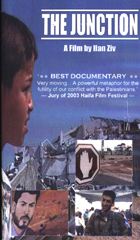
The Junction 2003
Distributed by First Run/Icarus Films, 32 Court St., 21st Floor, Brooklyn, NY 11201; 800-876-1710
Produced by Ilan Ziv
Directed by Ilan Ziv
VHS, color, 52 min.
Adult
Jewish Studies, Middle Eastern Studies
Date Entered: 08/06/2004
Reviewed by Michael J. Schau, Seminole Community College, Sanford, FLThe Junction is a documentary that focuses on the first two victims of the Palestinian uprising in the fall of 2000. Their deaths occurred when violence broke out near a crossroads in the Gaza Strip where the Jewish settlement of Netzarim and the Palestinian “refugee camp” Nusseirat meet. Fahmi Abou Ammouneh was a young Palestinian who took part in the riot against an Israeli military outpost guarding the settlement. Rocket firing Israeli helicopters broke up the assault, which led to Fahmi’s death. David Biri was an Israeli soldier assigned to the fort who was killed by a roadside bomb escorting civilians to their Netzarim settlement. This Palestinian area that had homes and orange groves was later razed by the Israeli military, which the film turns into an atrocity according to the Palestinians and selected Israeli’s interviewed.
Viewing this film is like watching a movie starting in the middle of a story with out any background leading up to that point. There are also assumptions made that do not stand up to facts and many facts are ignored. The film makes it appear that the assault against the army compound was only a spontaneous response against the Israeli occupiers because of Sharon’s visit to the Temple Mount, also the site of the Dome of the Rock, Islam’s third holiest site. Arafat’s chief of security Jabril Rajoub pre-approved Sharon’s visit. If unrest was supposedly started over the Israeli “occupation", by September 2000 the entire Gaza strip lived entirely under Palestinian jurisdiction and about 2% of the West Bank’s population lived in areas where Israel had complete control. By no conceivable stretching of the words could the violence be describes as a popular uprising against foreign occupation. This “popular uprising” was launched and choreographed by the leadership - and above all by Yasir Arafat. He needed a provocation and that is exactly how Sharon’s visit to the Temple Mount came off to the Palestinian’s, a provocation. The Palestinian Minister of Communications Imad Faluji later revealed that Arafat had been planning the newest infitada for months. Even with a manufactured crisis there were only minor clashes at the site. Not a single Palestinian was killed that day at the Temple Mount. It was the official Palestinian Authority media exhorting the Palestinians to violence.
Both of the youths’ deaths are directly linked to Palestinian actions but the film treats them as victims of a useless conflict where both sides are equally guilty. What is not shown in the assault against the fort is the Molotov cocktails (gasoline in bottles) thrown and sniper fire coming from the apartments towering over the fort, which precipitated the Israeli response. The film is not shown in chronological order of the events, which adds to the confusion in telling the story but also misrepresents the death of Israeli soldier, David Biri. He was riding a convoy escorting settlers back to their homes when they were halted by an explosion. While checking for damage a second bomb was deliberately set off while David was outside the armored vehicle, murdering him. This happened a whole day before the so called infitada.
Their families and friends in a depressing mix of bitterness and unthinking fanaticism recall both young men. In one scene the sister of the Palestinian was asked by the interviewer to acknowledge that Israelis have also died in the infitada. (In fact Israeli civilians were lynched, stabbed, killed in drive by shootings and other horrible ways. Israeli troops did not target innocent Palestinians, but Palestinians did target Israeli civilians). She barely shrugs and states that people everywhere die every day. Pretty cold. Everywhere in the Palestinian streets the film showed pictures of the local “martyrs” who blew themselves up killing Israelis. Rather than show how both families lost kids in a pointless conflict it made the Palestinians look like death-worshiping fanatics. Even the soldier David Biri came off in the home videos as a goofy kid who didn’t really know why he was there.
The fact that the infitada has brought only misery and economic ruin to the Palestinians is not addressed here. While the Sharon government is criticized, the Palestinian Authority is not rebuked for failing their people. This unbalanced, uncritical film does no one justice and is not recommended.
- Best Documentary, 2003 Haifa Film Festival